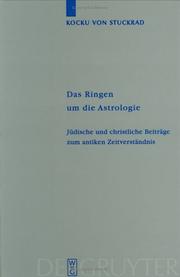| Listing 1 - 10 of 18 | << page >> |
Sort by
|

ISBN: 3110166410 3111748642 3110818663 9783110166415 Year: 2000 Volume: 46 Publisher: Berlin de Gruyter
Abstract | Keywords | Export | Availability | Bookmark
 Loading...
Loading...Choose an application
- Reference Manager
- EndNote
- RefWorks (Direct export to RefWorks)
Studies in the adaptation of astrological discourses in Judaism and Christianity in late antiquity. From the contents:Astrology and priestly theology in Qumran. Astrology in light of Jewish historiography. Evidence of astrology in the literature "between the Testaments." The rabbinic discourse. Astrology in the Christian canon. Astrology in the context of Gnosticism. Manichaean astrology. Anti-astrological discourses in centrist Christianity. Untersuchungen zur Adaption astrologischer Diskurse in Judentum und Christentum der Spätantike. Aus dem Inhalt:Astrologie und Priestertheologie in Qumran - Die Astrologie im Lichte der jüdischen Geschichtsschreibung - Die astrologischen Zeugnisse der "zwischentestamentlichen" Literatur - Der rabbinische Diskurs - Die Astrologie im christlichen Kanon - Astrologie im gnostischen Kontext - Manichäische Astrologie - Antiastrologische Diskurse im zentristischen Christentum.
115 --- 133.52 --- Tijd. Duur. Eeuwigheid --- Astrologie. Horoscopen. Dierenriem --- 292.1 --- Godsdiensten van de Grieken --- 133.52 Astrologie. Horoscopen. Dierenriem --- 115 Tijd. Duur. Eeuwigheid --- 292.1 Godsdiensten van de Grieken --- Astrology --- History --- Religious aspects. --- History. --- Horoscopy --- Astronomy, Medieval --- Occultism
Book
Year: 2006 Publisher: Stuttgart : Steiner,
Abstract | Keywords | Export | Availability | Bookmark
 Loading...
Loading...Choose an application
- Reference Manager
- EndNote
- RefWorks (Direct export to RefWorks)
Book
ISBN: 3515115501 Publisher: Franz Steiner Verlag
Abstract | Keywords | Export | Availability | Bookmark
 Loading...
Loading...Choose an application
- Reference Manager
- EndNote
- RefWorks (Direct export to RefWorks)
Book
ISBN: 3161523407 9783161523403 Year: 2013 Publisher: Tübingen Mohr Siebeck
Abstract | Keywords | Export | Availability | Bookmark
 Loading...
Loading...Choose an application
- Reference Manager
- EndNote
- RefWorks (Direct export to RefWorks)
Das Christentum kennt den Begriff Martyrium im modernen Wortsinn erst seit dem zweiten Jahrhundert. Katharina Waldner rekonstruiert die historischen Voraussetzungen für diese christliche Erfindung. Sichtbar wird dabei die kontingente Geschichte einer diskursiven Konstellation, in der die erzählerische Repräsentation juristischer Verfahren dazu genutzt wird, das Verhältnis zwischen politischer Macht, Wahrheit und Religion zu verhandeln. Im Mittelpunkt des ersten Teils stehen die platonische Darstellung von Prozess und Hinrichtung des Sokrates im Kontext der Religion Athens sowie die Erzählungen über religiöse Konflikte im hellenistischen Judäa (Danielbuch, 1. und 2. Makkabäerbuch). Vor diesem Hintergrund werden die entsprechenden jüdischen und christlichen Texte des ersten und zweiten Jahrhunderts analysiert. Resultat ist nicht nur eine differenziertere Sichtweise auf Praxis und Diskurs des frühen christlichen Martyriums, sondern auch die Geschichte individueller und kollektiver religiöser Identität im Spannungsfeld paganer, jüdischer und christlicher Praktiken und Diskurse.
Book
ISBN: 9783515120906 Year: 2019 Publisher: Stuttgart Franz Steiner Verlag
Abstract | Keywords | Export | Availability | Bookmark
 Loading...
Loading...Choose an application
- Reference Manager
- EndNote
- RefWorks (Direct export to RefWorks)
(Produktform)Electronic book text --- Askese --- Christentum --- Eucharistie --- Gender --- Hagiographie --- Heiligenviten --- Mönchtum --- Spätantike --- Veit Rosenberger --- agency --- (VLB-WN)9553
Book
ISBN: 9783111062624 Year: 2024 Publisher: Basel/Berlin/Boston : Walter de Gruyter GmbH,
Abstract | Keywords | Export | Availability | Bookmark
 Loading...
Loading...Choose an application
- Reference Manager
- EndNote
- RefWorks (Direct export to RefWorks)
Book
ISBN: 3515120904 Year: 2019 Publisher: Stuttgart : Franz Steiner Verlag,
Abstract | Keywords | Export | Availability | Bookmark
 Loading...
Loading...Choose an application
- Reference Manager
- EndNote
- RefWorks (Direct export to RefWorks)
Book
ISBN: 3111062627 Year: 2024 Publisher: Basel/Berlin/Boston : Walter de Gruyter GmbH,
Abstract | Keywords | Export | Availability | Bookmark
 Loading...
Loading...Choose an application
- Reference Manager
- EndNote
- RefWorks (Direct export to RefWorks)
Book
ISBN: 311068263X Year: 2021 Publisher: Berlin, Germany ; Boston, Massachusetts : Walter de Gruyter GmbH,
Abstract | Keywords | Export | Availability | Bookmark
 Loading...
Loading...Choose an application
- Reference Manager
- EndNote
- RefWorks (Direct export to RefWorks)
Martyrs create space and time through the actions they take, the fate they suffer, the stories they prompt, the cultural narratives against which they take place and the retelling of their tales in different places and contexts. The title "Desiring Martyrs" is meant in two senses. First, it refers to protagonists and antagonists of the martyrdom narratives who as literary characters seek martyrs and the way they inscribe certain kinds of cultural and social desire. Second, it describes the later celebration of martyrs via narrative, martyrdom acts, monuments, inscriptions, martyria, liturgical commemoration, pilgrimage, etc. Here there is a cultural desire to tell or remember a particular kind of story about the past that serves particular communal interests and goals. By applying the spatial turn to these ancient texts the volume seeks to advance a still nascent social geographical understanding of emergent Christian and Jewish martyrdom. It explores how martyr narratives engage pre-existing time-space configurations to result in new appropriations of earlier traditions.
Book
ISBN: 9783110682632 Year: 2020 Publisher: Mnchen Wien
Abstract | Keywords | Export | Availability | Bookmark
 Loading...
Loading...Choose an application
- Reference Manager
- EndNote
- RefWorks (Direct export to RefWorks)
| Listing 1 - 10 of 18 | << page >> |
Sort by
|

 Search
Search Feedback
Feedback About UniCat
About UniCat  Help
Help News
News